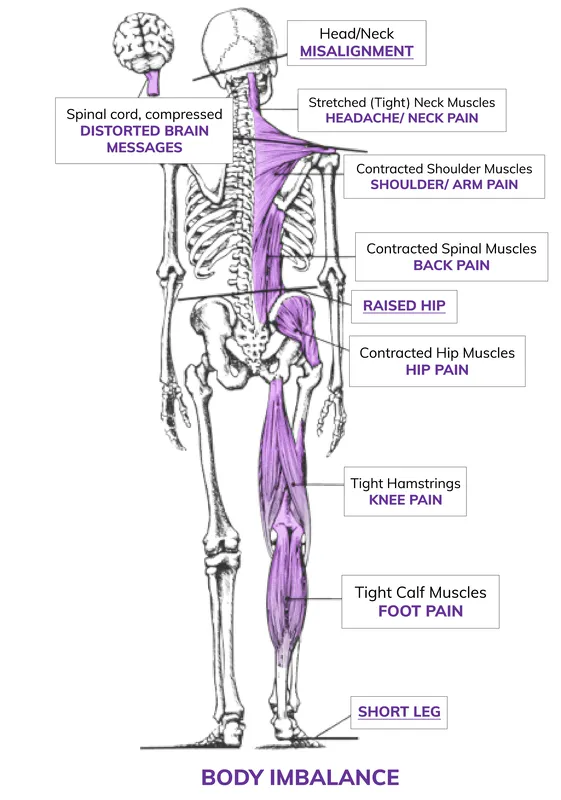New Patient Chiropractic Form
WHAT IS NUCCA
The National Upper Cervical Chiropractic Association (NUCCA) has developed a system of spinal restoration based on the body's own engineering and design.
The weakest region of the human spine is where the head meets the neck. This is due to fact that half of all of our head movements occur between the head and top two vertebrae. Injury will buckle this region of the spine in very large and complex ways, tearing loose connective tissue, ligaments and muscles responsible for maintaining normal posture and head alignment.
The result is the misalignment you see on the left, where the head, neck and top vertebrae (altas) have shifted sideways from their normal position. This causes stress and altered nerve flow to and from the brain and creates posture distortion and body imbalance as the entire spine shifts off center.
Utilizing a very precise system of analysis developed by NUCCA, which is based on scientific principles, doctors are able to calculate the precise reduction pathway and corrective force necessary to gently return proper positioning to the head and neck. As the correction in the upper neck is achieved, the associated postural asymmetry is also reduced.
This return of the body to a balanced position reduces stress on the joints and musculature.
Patients notice changes throughout their entire body as normal alignment is restored.


Upper Cervical Care Education
The nervous system controls every function in your body. It controls your immune system, emotions, vision, hearing, balance, breathing, heart rate, blood pressure, digestion, muscle tension, posture, hormones, and every other function. Nerve impulses or messages travel from the brain to every part of your body via the brainstem, which starts at the base of your skull and passes through the top two bones.
The Atlas and Axis bones are unlike any other bones in your spine.
They have no interlocking joints, allowing them to turn your head left/right and up/down.
Because of their range of motion, these bones are at a much higher risk to become subluxated or misaligned. If the top two bones in your spine become misaligned, unwanted pressure is applied to the brainstem. This inhibits proper communication from brain to body and causes health conditions to develop.
THE GOAL OF UPPER CERVICAL CARE
Upper Cervical care is a rapidly growing form of chiropractic that focuses on the intimate relationship between the first two bones in the neck, called the Upper Cervical spine, and a vital portion of the nervous system, known as the brain stem. The top two vertebrae, the Atlas and Axis, are especially vulnerable to injury or misalignment because they are the most mobile segments of the spine. A misalignment here can produce nerve pressure to the brain stem that can affect nearly all vital functions and systems in the body.
If neglected, an Upper Cervical misalignment can lead to irreversible spinal degeneration and chronic ill health. Upper Cervical misalignments can be caused by falls, auto accidents, sports, job injuries, concussions, physical or emotional stress, poor posture, or even birth trauma.
The goal of Upper Cervical care is to determine if and where you are subluxated/misaligned and act to correct it. Done correctly, the alignment becomes stable and holds in place, allowing the body to become healthier and stronger therefore requiring fewer corrections and decrease need for check up.
If a patient becomes subluxated and nothing is done to correct it, the opposite occurs. Your body stops and slows healing and can even begin to malfunction. Symptoms and diseases can reappear or develop. This will then require more frequent check ups to reestablish the healing process.
COMMONLY TREATED CONDITIONS
Acid Refulx
Allergies
Arthritis
Asthma
Carpal Tunnel Syndrome
Chronic Fatigue
Colic
Digestive Disorders
Epilepsy
Fibromyalgia
Headaches
High Blood Pressure
Immune Function
Irritable Bowel Syndrome
Knee Pain
Low Back Pain
Multiple Sclerosis
Neck Pain
Neurological Disorders
Scoliosis
TMJ Disorders
Neurological Disorders
Focusing on the Atlas and Axis
Focusing on the Atlas and AxisThe first big difference when it comes to upper cervical chiropractic care is that the focus is placed on adjusting just the top two bones in the neck. These bones are called the C1 and C2 vertebrae or the atlas and axis. They play a very specialized role and are unique from all of the other vertebrae.
Because they balance the head, even a slight misalignment in these two bones can result in changes throughout the spine. Also, because they are part of the cervical spine (7 neck bones), they help to facilitate blood flow to the brain via the vertebral foramen (tiny bone loops that offer safe passage to vertebral arteries).
The atlas plays an even more important role. It surrounds and protects the brainstem right at the vital juncture where it meets the spinal cord. Therefore, even the tiniest misalignment can affect the function of the central nervous system by putting pressure on the brainstem and reducing blood flow.


